Abstract:
Changes are necessary and inevitable in system or product development, but may lead to system deterioration, unexpected complications if not properly controlled.
System Impact analysis (SIA) is the activity of identifying the potential consequences of any changes (business need, new requirements, new technologies) we would like to make on a system or to determine what needs to be modified in order to make a change. So this helps us to determine the scope of the change, along with estimation of the resources we need for planning the changes.
SIA process also helps in identifying those dependencies which are not ideally visible while making any kind of changes in system. Hence SIA reveals hidden or unseen impacts in earlier stages which might deteriorate the project or increase the budget or time if not executed.
In this article, we discuss impact analysis from system engineering perspective, outline the steps followed in system impact analysis (SIA) process and present a framework to perform impact analysis. Also we have captured one case study to show the implementation of SIA.
The ultimate goal of the article is to provide a standard framework which can be used while performing SIA to predict all the possible impacts effectively before making any change in the system.
Keywords: System Impact analysis (SIA), Traceability, Dependency, Requirement
Introduction:
It is widely recognized that change is inescapable for any system such as staying current with industry trends, new business opportunities, improving productivity of product etc. However, unexpected complications often remain hidden while performing any technical changes to complex system. Hence System change if not properly controlled, lead to system deterioration, rework, and wasted work & money down the drain. E.g. Change in design of fuel pump in vehicle resulted in interruption with electrical power module leading to fuel pump to fail- https://etauto.com/s/7gscmw8, software change in Therac-25-https://youtu.be/Ap0orGCiou8.
E.g. Also most of the time, implication to all parts of the system or system as a whole not understood clearly. So it could be risky to jump into any system directly making change without a proper plan.
Conducting System Impact Analysis, we can learn what will be affected before making the actual changes. System Impact analysis is a tool for controlling change, and thus for avoiding deterioration. Impact analysis can be defined as “ the activity of identifying the potential consequences, including side effect and ripple effects, of a change(business need, new requirement, new technologies) or estimating what needs to be modified to accomplish a change before it has been made on a system”. Consequently, the output from impact analysis can be used as a basis for estimating the cost associated with a change. The cost of the change can be used to decide whether or not to implement it depending on its cost/benefit ratio.
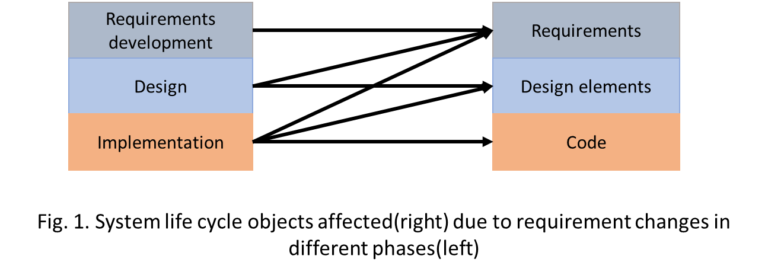
In our experience, impact analysis is an integral part of every phase in system development. During requirements development, design and prototype do not yet exist, so new and changing requirements affect only the existing requirements.
During design, proto or product does not yet exist, so new and changing requirements affect only existing requirements and design. Finally, during implementation, new and changing requirements affect existing requirements as well as design and proto.
This is captured in Fig. 1. Note that in less idealistic development processes, the situation still holds; requirements changes affect all existing system representations.
How to perform System Impact Analysis (SIA)?
Impact analysis can be performed in two steps.
i. Finding out relationships related to the subject element. There are two ways to find out the relationships:
- Static relationship/ Traceability study
- Review all static relationships related to subject including requirements, specifications, design elements and test cases to determine the scope of an initiating change.
- Manually determining what will be affected by a change can be extremely time consuming in complex projects, so various tools (e.g. requirement management software) can be used for traceability analysis.
b. Dynamic linkage/ Dependency study
- Used to determine the depth of the impact on the system.
- Review all the logical and dynamic linkages related to subject element including the use of variables, program logics, module architectures, data dependencies, control dependencies etc.
- Program Slicing techniques, use of tools for dependency analysis
ii. Review those relationships to uncover any possible consequences and risk associated with changes
- After performing traceability and dependency study we can obtain the full spectrum of relationships related to the subject elements. Then we can walk through the relationships one be one for evaluating the impact for the related elements when making changes.
- Experiential analysis- Taking into account the prior experience of experts in the organization, experiential impact analysis studies what happened in similar situations in the past to determine what may happen in the future.
A series of questions should be considered regarding the related elements being affected by the change, for example:
- Will the change lead to failure of running for other modules?
- Will the change causing performance drawback to the system?
- How much man power do we need to implement the change?
You may have more questions to ask during the review process depending on the subject of its nature, business decision as well as the complexity of the system.
Benefits of SIA:
Implementing SIA has the following benefits:
- Easy to review
- Visualizing all the scattered and unorganized relationships related to elements
- Knowing the scope of the change
- We can learn which will be affected by the change and level of impact
- Determine the depth of change
- Depth of impact is not restricted to one layer down, we can go deeper
- Plan forward for the resources needed by the change
- Allows the team to make accurate estimation regarding the resources that may be needed.
System Impact Analysis Lifecycle phases:
System impact analysis can be described in 3 steps:
- Change proposal phase
- Holistic understanding of implications of the change, identifies affected system
elements and analyzes impact
- Holistic understanding of implications of the change, identifies affected system
- Change approval phase
- Enables accurate estimation and technical assessment to make informed
business decisions
- Enables accurate estimation and technical assessment to make informed
- Implementation phase
- Provides a common definition, roadmap and basis to effectively drive
implementation of the change across the system
- Provides a common definition, roadmap and basis to effectively drive
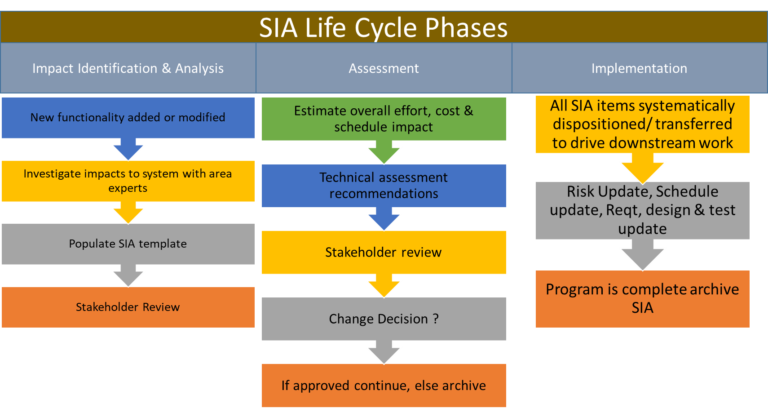
System Impact Analysis framework:
- Using SIA framework, we can capture relevant information and can do post analysis in an effective manner.
- It also helps in tracing and analyzing where and how the changes impact my whole system.
- Majorly can be used as a checklist.
- SIA framework consists of the following details:

System Impact Analysis Procedure:
There are 5 simple steps to conduct an effective system impact analysis are:
- Prepare the team
- Before we make any changes, we must prepare a team. All the team members must have an access to all the modules and attributes in the application and must also possess the required knowledge about the proposed changes.
- Inspect High-Level Modules
- The team members will then analyze the high-level modules (modules in the upper layer of current change) of the application which might be affected by the newly proposed change. This would provide them with a better knowledge of the workflow rules in the modules.
- Inspect Low-Level Modules
- After analyzing the high-level modules, the team would move towards the low-level modules (modules in the lower level of current change) and identify the impact of the new changes. A separate document has to be prepared for all the modules.
- Evaluate the Impact
- The framework prepared after analyzing the high and low-level modules will have all the details on the impact of the changes, both positive and negative.
- On the basis of this framework, the testers will evaluate the identified impacts, estimate the cost and time to fix the usage and will further get a clearer picture of the benefits and issues with the new changes.
- Work on Negative Impacts
- When the team members have a better idea of the negative impacts, and now, they can work on them. They can consult with the team and stakeholders and discuss if the change should be implemented or not. Regression testing can also be performed in this situation.
Conclusion on SIA:
Investment of SIA on project provides:
- Holistic understanding of the implications of the change on the project
- Clear picture of affected system elements because of change
- Accurate estimation of work required for the change
- Make informed decision for the project earlier and upfront
- Road map for change management
- Sound rationale and basis to support regulatory submission
- Minimize “surprises” to schedule and quality
- Skipping SIA does not change the size and complexity of the change itself, it just turns them into “Surprises”.
Case Study of SIA on PSS project:
To show the SIA process, here in this article we have taken a joystick system as a case study.
Joystick has following components:
- Joystick support
- Universal joint
- Wooden base
- Casing
- Spring
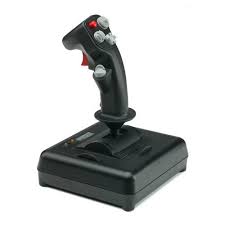

For the current case study, let us consider that the spring which is used in the joystick, is required to change because of supply chain constraints. Now let us see how SIA will help us to find out the impact of the above change by looking into what are the elements to which current change is related.
To find out the dependency of other elements with the current changed element, here we have used MBSE tool to trace back the related elements.
Using MBSE tool, first of all we have found out the current component is sub-part of which component, sub assembly and assembly.
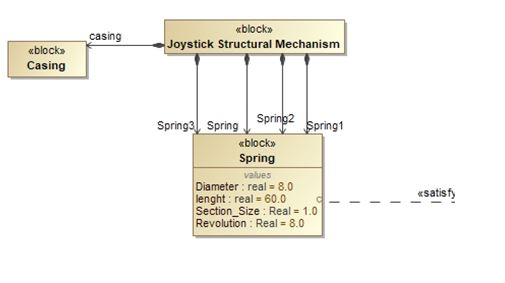
From the hierarchy, all the related constraints and requirements are traced using MBSE tool.

Now again using MBSE tool, further related derived requirements and components are traced back.
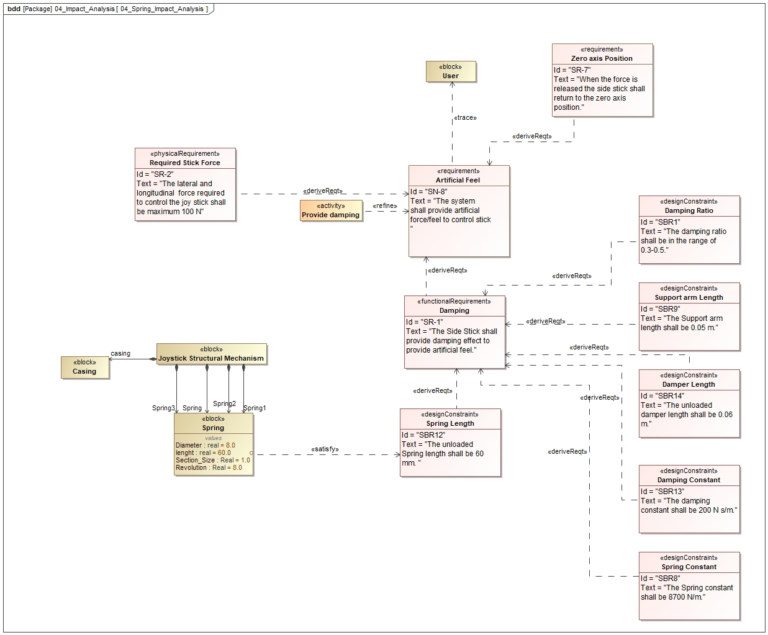
Above figure shows all the related elements to the spring configuration.
From the above figure, we can find out what are the elements which may affect because of the change in the spring configuration.
Using the above information now we can fill the SIA framework.

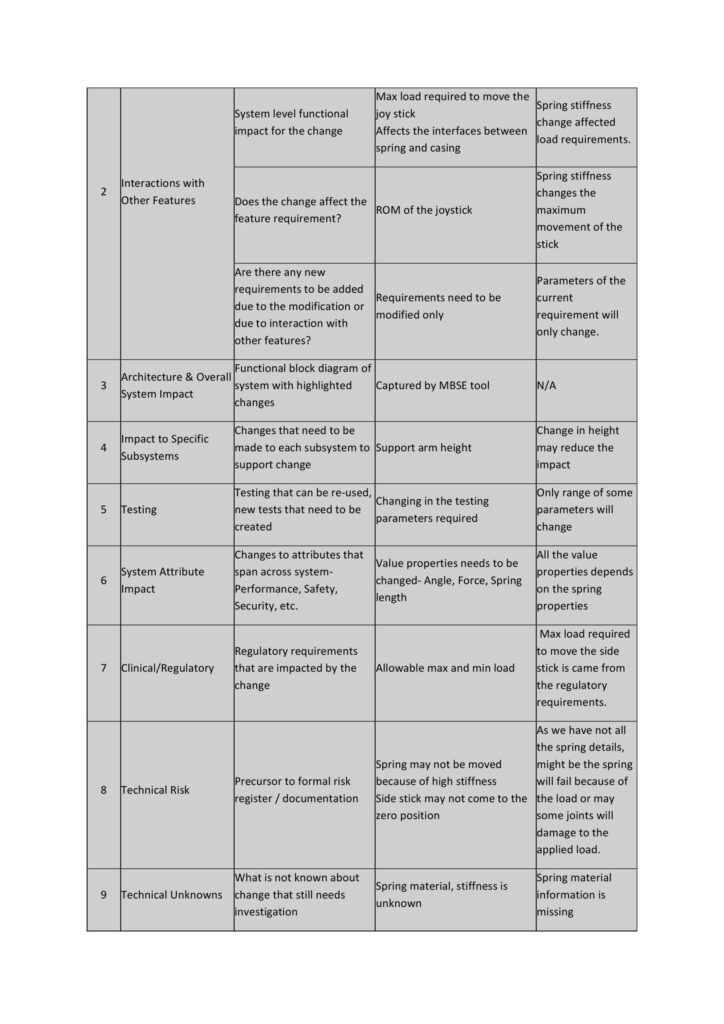
After capturing scope and depth of changes, some hand calculations are done to find out the maximum load possible with the new spring.

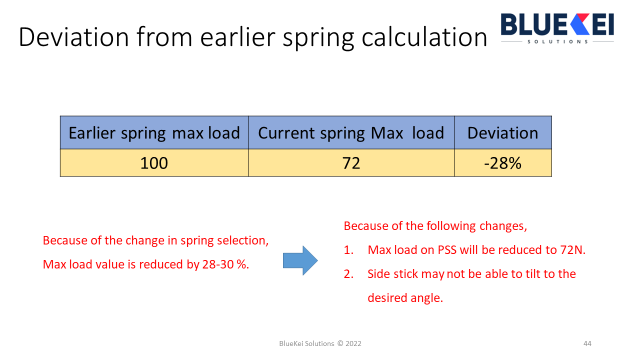
Conclusion of System Impact analysis on Joystick-
- Change in spring specification affects max load requirement of the system.
- As there is a risk of achieving the desired tilt angle, so there might be a change in system dimension.
- The height of stick may be required to reduce to acquire the desired tilt angle.
- Need to discuss with design team whether it is possible to change in design without changing the height of system and still possible to achieve the desired tilt angle.( As software or electronic parts may need enough height to accommodate all the electronic components)
If you are interested in understanding how to adopt systems engineering and model based systems engineering practices within your organization, reach out to BlueKei Solutions team at info@Blue-Kei.com. We specialize in systems engineering consulting, project executions, process adoptions such as compliance to ISO15288, ARP 4754A, ISO 42020, digital transformations. We can also conduct capability development workshops which are experiential and tailored to your needs. With systems engineering adoption you can address the complexity, manage evolving risks and bring transformation in communication within your organization through digitalization and create the digital thread.

